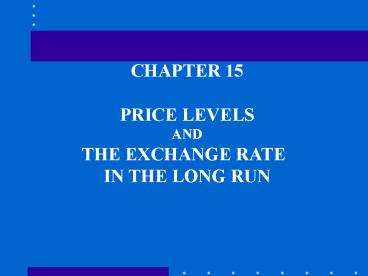PRICE LEVELS PowerPoint PPT Presentation
1 / 16
Title: PRICE LEVELS
1
CHAPTER 15 PRICE LEVELS AND THE EXCHANGE RATE
IN THE LONG RUN
2
What economic factors lie behind long term
movements in the exchange rates? The theory of
purchasing power parity (PPP) explains movements
in the exchange rate between two countries
currencies by changes in the countries price
levels. To have a good understanding of PPP we
need to know how the law of one price works.
3
THE LAW OF ONE PRICE PPP is based on the law of
one price. The law of one price states that in
the absence of transportation costs and official
trade barriers (tariffs or quotas), identical
goods, sold in different countries, must sell
for the same price when their prices are
expressed in terms of the same currency. Example
The law of one price can be expressed as
follows
4
PURCHASING POWER PARITY The theory of PPP states
that the exchange rate between two countries
currencies equals the ratio of countries price
levels. This can be expressed as follows. The
Relationship between PPP and the Law one
Price The law of one price applies to individual
commodities, while PPP applies to the general
price level. Absolute PPP and Relative
PPP Absolute and relative PPP can be expressed as
follows.
5
A LONG-RUN EXCHANGE RATE MODEL BASED ON PPP
The monetary approach to the exchange rates
combines PPP with the money market equilibrium
condition as follows. Therefore, in the long
run, the exchange rate is affected by the
following variables in the following way. 1.
Money Supplies
An increase in US money supply depreciates
E(/DM).
An increase in German money supply appreciates
E(/DM).
6
2. Money Demand A rise in real US money demand
appreciates E(/DM). A rise in real German money
demand depreciates E(/DM). 3. Output Levels A
rise in US output raises real US money demand and
appreciates E(/DM). A rise in German output
raises real German money demand and depreciates
E(/DM).
7
How Does a Change in Interest Rates Affect
E(/DM) in the Long Run? If the rise in R(US)
is due to a rise in real US interest, E(/DM)
appreciates. If the rise in R(US) is due to a
rise in US inflation rate, E(/DM) depreciates.
8
EMPIRICAL EVIDENCE ON PPP AND THE LAW OF ONE
PRICE All versions of PPP fail when confronted
with data. Examples The Law of One Price The
Hamburger Prices (p.409). Absolute PPP
Comparing the dollar price of consumer baskets. R
elative PPP Fig. 15-3.
9
EXPLAINING THE PROBLEMS WITH PPP The failure of
PPP is related to the following. 1. Trade
Barriers and Nontradables Contrary to the
assumption of the law of one price,
transportation costs and restrictions on trade
continue to exist. Therefore, some goods are not
traded internationally. These nontraded goods,
however, are included in the price indexes which
are used in testing PPP. 2. Departures from Free
Competition Monopolistic or oligopolistic
practices result in different prices in different
countries.
10
3. International Differences in Price
LevelMeasurement Commodity baskets differ in
content and quality even when there are no
barriers to trade and all products are tradable.
This can cause the PPP tests to fail. PPP in the
Short Run and in the Long Run Due to sticky
prices, departures from PPP are more pronounced
in the short run. National price levels still
diverge after all prices adjust and markets clear
in the long run.
11
A GENERAL MODEL OF LONG-RUN EXCHANGE RATES The
major prediction of PPP is that the real exchange
rates never change. Nominal Exchange Rate
E(/DM) The price of one national currency in
terms of another currency (i.e., the relative
price of two national currencies). Real Exchange
Rate q(/DM) Relative price of two output
baskets defined in terms of nominal exchange
rates and output levels. Example
12
A rise in q(/DM) (i.e., a real depreciation of
the U.S. dollar against the DM) implies a fall in
the purchasing power of a dollar within Germany
relative to its purchasing power within the
U.S. Demand, Supply, and the Long-Run Real
Exchange Rate Long-run values of the real
exchange rate change in response to a change
in 1. A change in world relative demand for
American products. Example 2. A change in
relative output supply. Example This can be
expressed as follows.
13
Nominal and Real Exchange Rates in Long-Run
Equilibrium Using the definition of the real
exchange rate, the nominal exchange rate can be
expressed as follows. The above equation takes
into account possible deviations from PPP by
adding the real exchange rate as an additional
determinant of the nominal exchange rate. Taking
into consideration the factors determining
q(/DM), P(US), and P(G), E(/DM) can be
expressed as follows.
14
How a Change in Money Supply, Money Demand, and
Output Affects the Real and Nominal Exchange
Rates in the Long Run
15
INTERNATIONAL INTEREST RATE DIFFERENTIALS AND THE
REAL EXCHANGE RATE Combining PPP and IRP we can
show that the difference between US and German
interest rates is the sum of two components (1)
the expected rate of real depreciation against
the DM, and (2) the expected inflation difference
between the U.S. and Germany. This relationship
can be derived as follows.
16
REAL INTEREST PARITY When relative PPP does not
hold, the real interest rates differ across
countries. This can be shown as follows.

